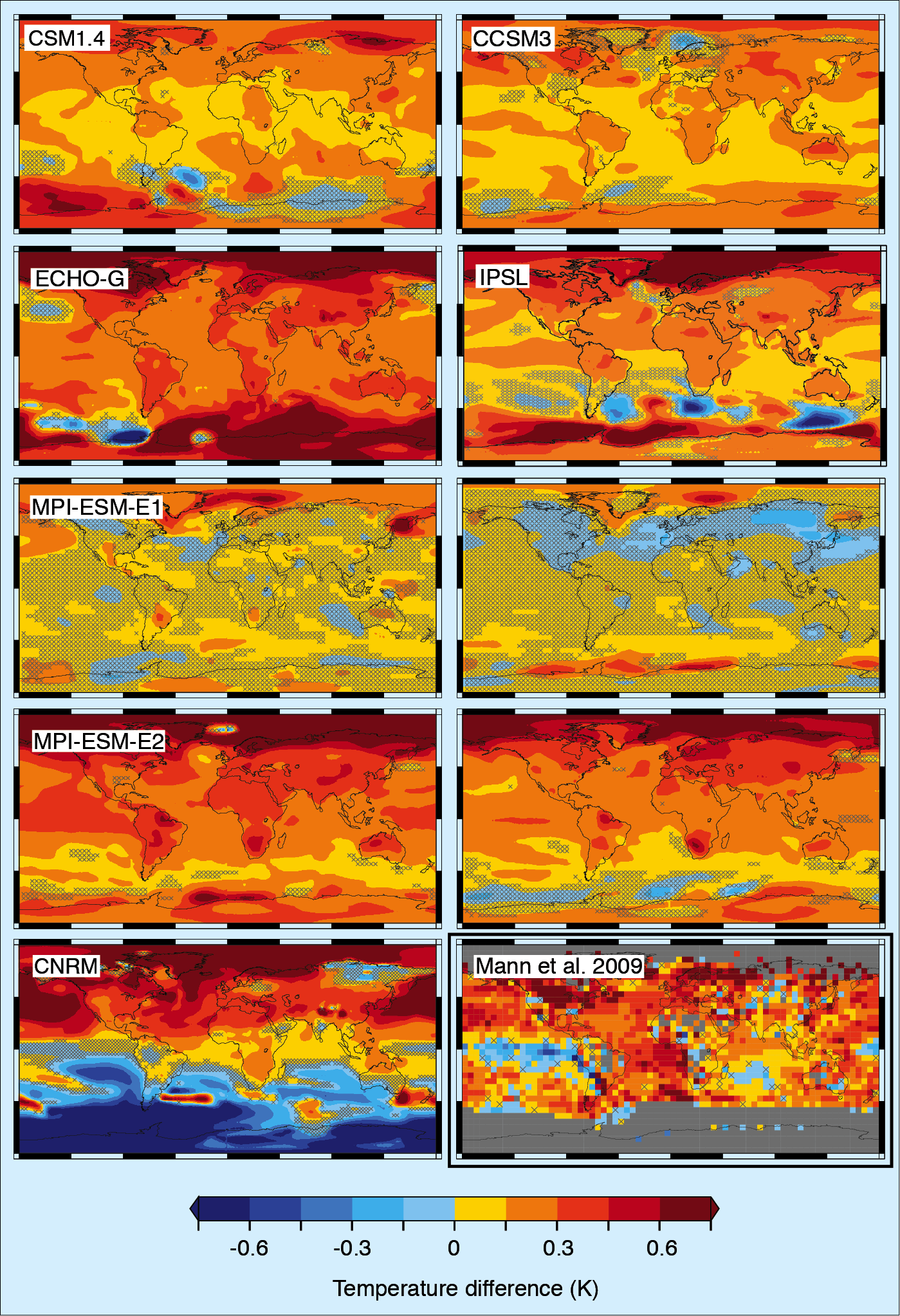- Home
- Publications
- PAGES Magazine
- Medieval Climate Anomaly To Little Ice Age Transition As Simulated By Current Climate Models
Medieval Climate Anomaly to Little Ice Age transition as simulated by current climate models
Fidel J. González-Rouco, L. Fernández-Donado, C.C. Raible, D. Barriopedro , J. Luterbacher, J.H. Jungclaus, D. Swingedouw, J. Servonnat, E. Zorita, S. Wagner and C.M. Ammann
Past Global Changes Magazine
19(1)
7-8
2011
Fidel J. González-Rouco1, L. Fernández-Donado1, C.C. Raible2,3, D. Barriopedro4 , J. Luterbacher5, J.H. Jungclaus6, D. Swingedouw7, J. Servonnat7, E. Zorita8, S. Wagner8 and C.M. Ammann9
1Departamento Astrofísica y CC. de la Atmósfera, Universidad Complutense de Madrid, Spain; fidelgr fis.ucm.es
fis.ucm.es
2Climate and Environmental Physics, University of Bern, Switzerland
3Oeschger Centre for Cimate Change Research, University of Bern, Switzerland
4Laboratory IDL, University of Lisbon, Portugal
5Department of Geography, Justus Liebig University Giessen, Germany
6Max Planck Institute for Meteorology, Hamburg, Germany
7Laboratoire des Sciences du Climat et de l’Environnement, Gif-sur-Yvette, France
8Helmholtz-Zentrum Geesthacht, Germany
9National Center for Atmospheric Research, Boulder, USA
Inter-model differences and model/reconstruction comparisons suggest that simulations of the Medieval Climate Anomaly either fail to reproduce the mechanisms of climate response to changes in external forcing, or that anomalies during this period are largely influenced by internal variability.
Comparing model simulations with proxy-based climate reconstructions offers the possibility to explain mechanisms of climate variability during key periods, such as the Medieval Climate Anomaly (MCA) and the Little Ice Age (LIA). Discrepancies between both sources of information may also help to identify possible deficiencies in our understanding of past climate, its modeling or its representation by proxy records.
Information derived from proxy records suggests the following picture of the MCA in comparison to the subsequent colder period, the LIA, that involves quasi-coordinated climate shifts across different regions of the globe (e.g., Seager et al., 2007; Mann et al., 2009; Graham et al., 2010): evidences of an increased zonal gradient in the tropical Pacific produced by La Niña-like conditions in the eastern Pacific and anomalous warmth in the western Pacific and Indian Ocean, and a broad expansion of the Hadley Cell with associated northward shift of the zonal circulation that might have led to a more positive North Atlantic Oscillation (NAO) type of signature in the North Atlantic. Graham et al. (2010) recently showed that a pattern of change consistent with such anomalies is obtained for the MCA with an Atmosphere Ocean General Circulation Model (AOGCM) if anomalously warm sea surface temperatures are induced on the Indian Ocean and western tropical Pacific.
Current AOGCM millennial forced simulations do represent an overall warmer MCA and a cooler LIA at global and hemispherical scales (e.g., González-Rouco et al., 2006; Ammann et al., 2007) as a response to long-term changes in volcanic activity and solar irradiance. The amplitude of this response is dependent on the model sensitivity and on the specific set of forcing reconstructions used to drive the simulations. Mann et al. (2009) show that in spite of agreement in simulating global and hemispheric warming, the reconstructed pattern of MCA-LIA temperature change, and specifically the La Niña-like conditions in the eastern Pacific, were not reproduced by forced simulations with the GISS-ER and the NCAR CSM1.4 climate models. In this contribution, we will examine the MCA-LIA transition in all available high complexity AOGCM transient simulations of the last millennium.
Simulation of MCA-LIA temperature difference by AOGCMs
Simulations from six different AOGCMs are considered (see original references for details): the National Center for Atmospheric Research Climate System Model 1.4 (Ammann et al., 2007; CSM1.4 hereafter); a new version of the same model, the Community Climate System Model 3 (Hofer et al., 2011; CCSM3 hereafter); the Max Planck Institute for Meteorology ECHO-G (González-Rouco et al., 2006); the Institute Pierre Simon Laplace IPSLCM4_v2 (Servonnat et al., 2010; IPSL hereafter); the Centre National de Recherches Météorologiques CNRM-CM3.3 (Swingedouw et al., 2010; CNRM hereafter); and the Max Plank Institute for Meteorology Earth System Model (Jungclaus et al., 2010; MPI-ESM hereafter). This suite of simulations has been performed by different groups and institutions and represents forcing uncertainty through somewhat different choices of external forcing. Only some comments about the forcing that are relevant for the MCA-LIA period are provided herein.
All simulations incorporate solar variability, volcanic activity (except for IPSL) and greenhouse gas concentration changes. Variations in solar irradiance for the last millennium are smaller than previously thought (see discussion in Jungclaus et al., 2010 and Schmidt et al., 2011). The majority of simulations were performed with a comparatively high solar variability scenario, except for the specific case of MPI-ESM for which two different ensembles were made including smaller (E1) and larger (E2) irradiance changes. The total solar irradiance (TSI) change in the high solar variability scenarios ranges from 0.24% (CSM1.4, CCSM3) to 0.29% (ECHO-G) from the Late Maunder Minimum (LMM) to present and from 0.17% (CCSM3) to 0.27% (MPI-ESM-E2) from the MCA to the LMM; in MPI-ESM-E1 the values of TSI change are of 0.09% (0.04%) for the transition LMM-present (MCA-LMM). Volcanic forcing was implemented differently in the suite of models, although comparable global and annual averages were retained. With regard to greenhouse gases, all models incorporate prescribed values of CO2 concentration except for MPI-ESM, which interactively calculates them within the carbon cycle submodel. Similarly, land use changes before 1700 AD are incorporated only in the MPI-ESM simulations as variations in vegetation types due to agricultural activities.
Figure 1 shows the MCA–LIA annual temperature differences (hatched areas indicate non significance for a p<0.05 level) in a forced simulation from each of the six models and also in the proxy-based reconstruction from Mann et al. (2009). For the specific case of the MPI-ESM model, results are shown for four simulations, two arbitrarily selected from each ensemble to illustrate the existing differences between the members. All simulations tend to produce an almost globally warmer MCA, except for the one of CNRM, which shows a large cooling in the Southern Hemisphere. Warming tends to be higher over the continents than oceans, particularly over the sea-ice boundary at the high latitudes of both hemispheres. Regional scale cooling (not significant everywhere) is simulated around Antarctica, mid-latitudes of the Southern Hemisphere (all models), in the North Pacific (ECHO-G), in the North Atlantic (CCSM3) or in northern Asia (CNRM). However, many of these regional scale features may well be simulation-dependent and related to initial conditions and internal variability as evidenced by the differences within the members of each MPI-ESM ensemble. Differences arise in the magnitude of warming and cooling over the North Pacific, South America or Africa in E2 or in the spread of cooling regions in the E1 members. Among the two ensembles, E1 simulates more regional/large-scale widespread cooling, a sign of the lower weight of TSI changes that allows for internal variability to become more prominent. Therefore, even if widespread warming is simulated in the MCA, the spatial pattern of temperature change is very heterogeneous and can vary considerably from model to model and even within simulations of the same model.
None of the model simulations reproduce the reconstructed pattern in Mann et al. (2009) depicting a La Niña-like state in the Pacific. Other features in the reconstructed evidence discussed by Graham et al. (2010) are also not evident in the simulated MCA–LIA temperature differences. This includes the anomalous warm pool over the western Pacific- Indian Ocean and enhanced tropical zonal temperature gradient, as well as an NAO-like temperature signature, suggestive of a northward shift of the zonal circulation. Therefore apart from the generally higher changes in continental and polar areas, the MCA–LIA change across the available model simulations is inconsistent, and shows a different response to proxy evidences.
Conclusions
The results presented here highlight major discrepancies between millennium simulations and reconstructions. If proxy-based reconstructions were considered reliable and changes in radiative forcing factors were responsible for the MCA–LIA reconstructed temperature signal, these results would have implications on our understanding of the MCA–LIA transition. These discrepancies suggest that either the MCA–LIA changes arose from internal variability only, or transient simulations with state-of-the-art AOGCMs fail to correctly reproduce some mechanisms of response to external forcing: for instance, changes in the tropics like the enhancement of the zonal gradient in the tropical Pacific is not well simulated, with implications for related teleconnections elsewhere.
Most models have used relatively high TSI variations from the MCA to the LIA and their pattern of response is typically a uniform warming in the earlier period. In spite of this, there are considerable differences among the simulations that highlight a feasible influence of initial conditions and internal variability. Furthermore, if reduced levels of past TSI are given more credit, as in the MPI-ESM-E1 ensemble, the temperature response for the MCA–LIA is less uniform in sign and visibly more influenced by internal variability. Therefore, under both high and low TSI change scenarios, it is possible that the MCA–LIA reconstructed anomalies would have been largely influenced by internal variability.
references
For full references please consult: http://pastglobalchanges.org/products/newsletters/ref2011_1.html


